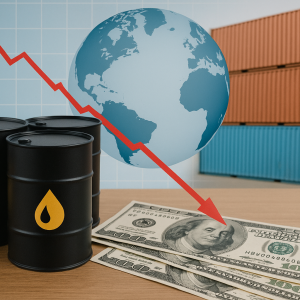Italian economy growing, but different speeds: services good, tourism record, industry bad.
Saturday 18 May 2024
Share on
Italian economy growing, but at different speeds: record tourism, good services and net exports, bad industry. Employment still up, but hours authorised for Cassa Integrazione also rise. Oil price high but moderating, EU inflation keeps ECB rates high. Freight transport by sea: longer routes and high costs. Eurozone on the rise, USA on the brakes, good growth in China.
- Only part of the economy is growing. In Q1 2024, Italian GDP grew (+0.3%), although industry output and goods consumption contracted. On the positive side were tourism (at record levels), services (growing moderately) and net exports. On the negative side are the problems in the global transport of goods, the still expensive energy, and the high interest rates. Household and business confidence is falling.
- Oil: high but moderating price. The price of oil, after peaking in April, reversed its trend in May (83 dollars per barrel, up from 90), but at a still high level: OECD crude oil stocks recovered to some extent, although supply in Opec countries remains limited, a sign of weak global oil demand. The price of gas, on the other hand, continued its slow upward trend (30 €/mwh in May, up from 26 in February), at more than double the level of 2019.
- EU inflation keeps rates high. In Italy, inflation remained low in April (+0.8%): the drop in energy prices eased (-12.1% per year, from -24.7% at the end of 2023), while core prices slowed (+2.1%). But in the Eurozone, the decline stopped (+2.4%), with core high (+2.7%) from +2.0%. US inflation surprised to the upside in March (+3.5%). Therefore, the Fed and ECB in April-May held rates steady (5.50% and 4.50%): markets expect a first cut in Europe in June-July.
- Domestic demand falls. Credit continues not to help consumption and investment, although rates have fallen little and the drop in loans has stopped for businesses. In March, the CCI reported a slowdown in consumption, particularly of goods, confirmed by declining retail sales (-0.1% in the month and -0.4% in Q1). In April, household confidence fell for the second month and orders from companies producing capital goods continued their downward trend: a bad start to Q2.
- It increases work. In Q1 the number of employed persons continued to grow (+0.2%), the result of +133 thousand permanent employees (+0.8%), -72 thousand temporary employees (-2.5%) and almost stable self-employed persons. However, the rise in authorised CIG hours (+8.6% over 1Q2023) signals some slowdown in labour input utilisation. Contractual wages in the private sector accelerated: +4.7% in industry in Q1 2024 (+3.2% in 2023), +2.3% in services (from +1.3%), compared to +0.9% for inflation.
- Services grow less. Foreign tourism in January-February grew by +20% in current spending over 2023, which was already a record year. In March, RTT (CSC-TeamSystem) in services declined (-3.2%), but Q1 ended with +2.3%. In April, the PMI also fell slightly (54.3 from 54.6), continuing to indicate growth, and business confidence also fell to its lowest level since early 2024.
- Industry still down. In March, there was a further decline in RTT in industry, after the slight one in February; together with the drop in inventories, this is consistent with the decline in production (-0.5% in March, -1.3% in Q1). For April, all indicators were negative: the HCOB PMI slipped back into the contraction area (47.3 from 50.4); the CSC quick survey shows a slight worsening of production expectations; the swing in manufacturing business confidence continued at low levels.
- Net exports raise GDP. In Q1, Italian imports of goods fell sharply (-2.8% in volume), more than exports (-0.8%): this made a positive contribution to GDP and increased the trade balance (+€12.8 billion). World trade stagnated in the first two months (-0.1% over 4Q23).
- Eurozone on the rise. In Q1 the area's GDP returned to growth (+0.3%), after two quarters of slight decline. What is new is the partial recovery in Germany (+0.2% after -0.5%); the other main countries remain in growth. The expansion in 2024, however, is only +0.3%. In March, German industrial production fell (-0.7%), but is +0.3% in Q1. In April, confidence (ESI below 2023 average) and labour market expectations worsened (EEI to 101.8 from 102.5).
- USA on the brakes. US GDP in Q1 slowed (+0.4% from +0.8%), with consumption (+0.4%) and investment contributing positively, inventories and net exports (-0.2%) negatively. Acquired growth in 2024 is already +1.8%. Industrial production in the 1st fell by -0.5%, as in the 4th 2023, but the drop was in December-January: in the following two months, a rebound (+0.4% per month). In April, jobs created declined (175,000, from an average 269,000 in the 1st), as did nominal wage growth (+0.2%, from +0.3%).
- Good China. China closed Q1 above expectations (trend GDP +5.3%), driven by manufacturing (+6.1%), especially high-tech sectors: +40% in 3D printers, electric car charging stations, other electronic components. The start of the 2nd quarter was good, with manufacturing accelerating in April (PMI at 51.4). In the coming months, an unfavourable base effect on GDP and export uncertainty due to new US restrictions will weigh on the economy: government support may be decisive for the growth target at 5.0%.
Focus of the month - Sea transport: longer routes, high costs
- Maritime transport under pressure. Geopolitical and climatic factors undermine the security and reliability of global freight transport: Houti attacks in the Red Sea, piracy in the Strait of Malacca, drought in the Panama Canal, tensions in the Taiwan Strait. Crucial hubs of global trade in goods are affected: about 80% in volume and 50% in value are by sea.
- The reaction of the operators. The world's major carriers reacted by altering routes, reorganising fleets, increasing ship speeds. And by increasing the cost of shipping (so-called freight rates).
- Fewer passages in maritime 'straits'. From the beginning of December 2023 to the beginning of May 2024, Red Sea transits fell by 61.5%, while those around Africa grew by 91.5%. Since the end of February, transits to Malacca (one of the world's most important hubs) have fallen by 37.9%. As a result, total transits in the major maritime chokepoints (straits) decreased sharply (-22.6% the CSC indicator).
- More costs. As a result, shipping costs between Asia and Europe jumped and, to a lesser extent, those between Asia and America. In particular: Shanghai-Genoa freight rates increased by a good three and a half times at the end of January, and then only partially recovered (still +207.4% at the beginning of May); equivalent dynamics for Shanghai-Rotterdam (+216.7%). Freight rates between China and the United States reacted with a slight lag, peaking in February and registering increases of about +1001.4% at the beginning of May. The Shanghai-New York route also remains expensive due to the half service operation in the Panama Canal. Overall, global shipping costs were 128.6% higher at the beginning of May than five months earlier. In the medium term, an increase in the shipping fleet could provide the necessary capacity for permanently longer routes. But variable shipping costs (hours worked, fuel consumption) would remain higher (for Italy +50% with Japan, +70% with China, +170% with India, in terms of distance).
- The transmission channels for Italy. Rising freight rates impact the price of imported goods and the competitiveness of Italian products, both directly and indirectly, i.e. through the cost and availability of raw materials and semi-finished goods purchased abroad. In Q1 2024, around one third of manufacturing companies experienced delays in the procurement of inputs or higher transport costs (Bank of Italy Inflation and Growth Expectations Survey). This also weighs on foreign accounts, because Italian industry often delegates the management of the logistics chain to foreign counterparts.
- The Italian exposure to the 'Suez route'. Sea transport accounts for a large part of Italian trade, especially on the import side: almost 60% of purchases from abroad in volume (35% in value); these flows by sea come largely from non-EU markets. Compared to a subset of 39 Asian and Middle Eastern countries located beyond the Suez Canal, the exchange of goods (import + export) with Italy in 2023 was almost a third of the total with the extra-EU; the exposure increases when considering only Italian imports (40% out of the extra-EU total) and in particular those by sea (almost 50%).
- Impact on producer prices in manufacturing. The CSC estimated, using input-output tables, the effect of the increase in shipping costs on the output prices of individual manufacturing sectors, resulting from both imported manufacturing inputs and interrelationships between domestic sectors. Based on the observed changes in shipping costs, it was estimated that the increase in shipping costs has moderate effects, in aggregate, on output prices in manufacturing, averaging +0.9%, but with important sectoral differences. Chemistry and metallurgy are the sectors where changes in input prices have the greatest effect, by +3.6% and +3.4% respectively. However, this effect is currently offset by a deflationary push from China on some manufactured goods. In fact, import prices in Italy register -1.6% in Q1 2024 compared to Q4 2023.





















